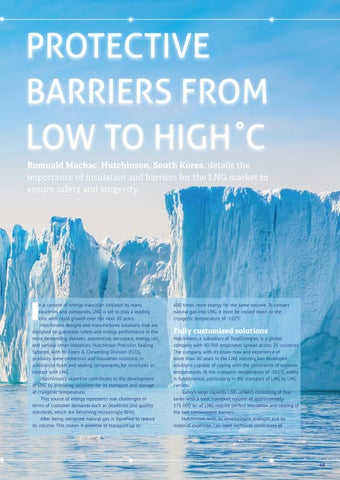Romuald Machac, Hutchinson, South Korea, details the importance of insulation and barriers for the LNG market to ensure safety and longevity.
I
n a context of energy transition initiated by many countries and companies, LNG is set to play a leading role with rapid growth over the next 20 years. Hutchinson designs and manufactures solutions that are designed to guarantee safety and energy performance in the most demanding markets: automotive, aerospace, energy, rail, and various other industries. Hutchinson Precision Sealing Systems, with its Foam & Converting Division (FCD), produces some protection and insulation solutions, in addition to foam and sealing components, for structures in contact with LNG. Hutchinson’s expertise contributes to the development of LNG by providing solutions for its transport and storage at cryogenic temperature. This source of energy represents real challenges in terms of customer demands such as deadlines and quality standards, which are becoming increasingly strict. After being extracted, natural gas is liquefied to reduce its volume. This makes it possible to transport up to
600 times more energy for the same volume. To convert natural gas into LNG, it must be cooled down to the cryogenic temperature of -162˚C.
Fully customised solutions
Hutchinson, a subsidiary of TotalEnergies, is a global company with 40 000 employees spread across 25 countries. The company, with its know-how and experience of more than 30 years in the LNG industry, has developed solutions capable of coping with the constraints of extreme temperatures. At the cryogenic temperature of -162˚C, safety is fundamental, particularly in the transport of LNG by LNG carriers. Today’s large capacity LNG tankers, consisting of four tanks with a total transport volume of approximately 175 000 m3 of LNG, require perfect insulation and sealing of the two containment barriers. Hutchinson, with its development strength and its material expertise, can meet technical constraints of
45










